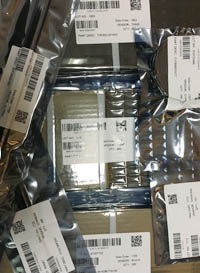| Part Number | STA120D13TR |
|---|---|
| Manufacturer | STMicroelectronics |
| Description | IC RCVR DGTL AUDIO 28SOIC |
| Datasheet | |
| Package | 28-SOIC (0.295", 7.50mm Width) |
| ECAD |
|
| In Stock | 28,020 piece(s) |
| Unit Price | Request a Quote |
| Lead Time | Can Ship Immediately |
| Estimated Delivery Time | Apr 28 - May 3 (Choose Expedited Shipping) |
| Request for Quotation |
|
| Payment Methods | |
| Delivery Services |
Part Number # STA120D13TR (Audio Special Purpose) is manufactured by STMicroelectronics and distributed by Heisener. Being one of the leading electronics distributors, we carry many kinds of electronic components from some of the world’s top class manufacturers. Their quality is guaranteed by its stringent quality control to meet all required standards.
For STA120D13TR specifications/configurations, quotation, lead time, payment terms of further enquiries please have no hesitation to contact us. To process your RFQ, please add STA120D13TR with quantity into BOM. Heisener.com does NOT require any registration to request a quote of STA120D13TR.
Aminah*****padhyay
March 30, 2023
King***** Desai
March 30, 2023
Brand*****evens
March 24, 2023
Lyri*****cker
March 23, 2023
Luk*****ath
March 10, 2023
Aaro*****ylor
March 8, 2023
Adri***** Kakar
March 4, 2023
Pau*****aughn
February 20, 2023





We guarantee 100% customer satisfaction.
Our experienced sales team and tech support team back our services to satisfy all our customers.

We provide 90 days warranty.
If the items you received were not in perfect quality, we would be responsible for your refund or replacement, but the items must be returned in their original condition.
| Part Number | Manufacturer | Description | Stock |
STA120DJ13TR D# V99:2348_18457054 |
STMicroelectronics |
Audio Processor 6.4MHz to 25MHz 28-Pin SO RoHS: Compliant
|
0 |
| Part Number | Manufacturer | Description | Stock |
STA120DJ13TR D# STA120DJ13TR |
STMicroelectronics |
Digital Audio Interface Receiver 28-Pin SO T/R - Tape and Reel (Alt: STA120DJ13TR) |
0 |
| Part Number | Manufacturer | Description | Stock |
STA120D13TR D# STA120D13TR |
STMicroelectronics |
Digital Audio Interface Receiver 28-Pin SO T/R (Alt: STA120D13TR) |
0 |
STA120DJ13TR D# STA120DJ13TR |
STMicroelectronics |
Digital Audio Interface Receiver 28-Pin SO T/R (Alt: STA120DJ13TR) |
0 |
| Part Number | Manufacturer | Description | Stock |
STA120D13TR |
STMicroelectronics |
STA120 Series 3.6 V Surface Mount Digital Audio Interface Receiver - SOIC-28 |
0 |
STA120DJ13TR |
STMicroelectronics |
Min Qty 1000 |
0 |
| Part Number | Manufacturer | Description | Stock |
STA120D13TR |
STMicroelectronics |
RoHS: Compliant
|
0 |
| Part Number | Manufacturer | Description | Stock |
STA120D13TR D# STA120D13TR-ND |
STMicroelectronics |
IC AUDIO RECEIVER 28SO |
0 |
STA120DJ13TR D# 497-3943-2-ND |
STMicroelectronics |
IC AUDIO RECEIVER 28SO |
0 |
| Part Number | Manufacturer | Description | Stock |
STA120D13TR |
STMicroelectronics |
In stock shipping within 2days |
1255 |
| Part Number | Manufacturer | Description | Stock |
STA120DJ13TR |
OEM/CM QUOTES ONLY | NO BROKERS |
5950 | |
STA120D13TR |
STMicroelectronics |
OEM/CM QUOTES ONLY | NO BROKERS |
2781 |
| Part Number | Manufacturer | Description | Stock |
STA120DJ13TR |
STMicroelectronics |
OEM/CM Immediate delivery |
30000 |
STA120D13TR |
STMicroelectronics |
OEM/CM Immediate delivery |
1262 |
| Part Number | Manufacturer | Description | Stock |
STA120DJ13TR D# 59T4152 |
STMicroelectronics |
CONDITIONING & INTERFACES RoHS: Not Compliant
Min Qty: 1000
Container: TAPE & REEL - FULL
|
0 |
| Part Number | Manufacturer | Description | Stock |
STA120D13TR D# NS-STA120D13TR |
STMicroelectronics |
OEM/CM ONLY |
9945 |
| Part Number | Manufacturer | Description | Stock |
STA120DJ13TR |
STMicroelectronics |
CONSUMER CIRCUIT, CMOS, PDSO28 |
3296 |
| Part Number | Manufacturer | Description | Stock |
STA120D13TR |
STMicroelectronics |
OEM/CM ONLY |
766 |
STA120DJ13TR |
STMicroelectronics |
OEM/CM ONLY |
3312 |
| Part Number | Manufacturer | Description | Stock |
STA120D13TR |
STMicroelectronics |
IN stock Immediate delivery |
1277 |
STA120DJ13TR |
STMicroelectronics |
IN stock Immediate delivery |
29985 |
| Part Number | Manufacturer | Description | Stock |
STA120D13TR |
STMicroelectronics |
shipping today |
101466 |
STA120DJ13TR |
STMicroelectronics |
shipping today |
98 |
| Part Number | Manufacturer | Description | Stock |
STA120D13TR |
STMicroelectronics |
RFQ |
1734 |
Heisener's commitment to quality has shaped our processes for sourcing, testing, shipping, and every step in between. This foundation underlies each component we sell.

Do you have any question about STA120D13TR?
+86-755-83210559-827



Scan to view this page